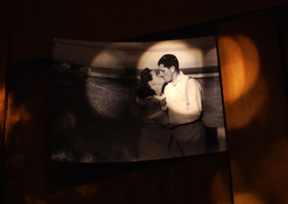The Other Day
El otro día CHILE / 2012 / Spanish / Color / Blu-ray / 122 min
CHILE / 2012 / Spanish / Color / Blu-ray / 122 min
Director, Script, Photography, Sound, Narration, Producer: Ignacio Agüero
Editing: Sophie França
Co-producers: Christian Aspée, Daniela Salazar
Associate Producer: Amalric de Pontcharra
Additional Photography: Arnaldo Rodríguez, Gabriel Díaz, Claudia Serrano
Production Company and Source: ignacio agüero & associate
A house in Santiago, Chile. The subtle and beautiful cinematography of director Ignacio Agüero leads viewers deep into the memories of a single household. Occasionally the doorbell rings, and a guest arrives to interrupt. But the head of the household, our director, has an interest in these guests, and follows them into their daily lives. Through familiar homes and city streets, as well as conversations with people who live and work there, The Other Day poetically intertwines family history with a contemporary history of Chile.
[Director’s Statement] When I am filming, I need to keep asking myself what the film is about—not to answer the question, but rather to keep on exploring its meaning. For me, a good idea for a film is one that allows freeing oneself from the slavery of following a story. In this way, I don’t seek images to express or tell something, but rather I seek, in the images, the path that they themselves suggest.
In The Other Day, I want to pause in the present and pay attention to the vibration of the moment and the space. That is, to follow the sunlight and listen, to turn my head towards what is drawing my attention. The points of focus are in the space that surrounds the camera, and in the brain of the person filming. The eye looks both forward and backwards. Looking forward you find the space in which the body can move, and looking backwards (behind the eye) is the inside of the body, the brain. The eye also looks there, producing a dialogue between thought, imagination, memory, and the world that is in front of the eyes—a mixture of images which is what constitutes reality. Moreover, the eye sees both when the lid is open and when it is closed.
All this can be interrupted by the unexpected and random presence of those who knock on your door, those who are not filmmakers and who need something from you. That is when the spatial relationship changes. The interior becomes the inside of my house and the exterior becomes the city. And the point of interest becomes the others, from whom I also need something, their conversation. So what is the film about?
 Ignacio Agüero
Ignacio Agüero
Born in Santiago, Chile in 1952, Ignacio Agüero has made several televised films. He co-directed the NO to Pinochet television spots for the 1988 plebiscite. Agüero has worked as head of the Association of Documentary Filmmakers and as an actor, playing both supporting and leading roles in some of Raúl Ruiz’s latest films. He now directs the Master’s Degree program in documentary filmmaking at the Universidad de Chile. He has made the documentaries Not to Forget (1982), The Way I Feel Like It (1985), One Hundred Children Waiting for a Train (1988, YIDFF ’89), Dreams of Ice (1993, YIDFF ’93), Under Construction (2000), My Grandmother’s Mother Told My Grandmother (2004), and Agustin’s Newspaper (2008).
